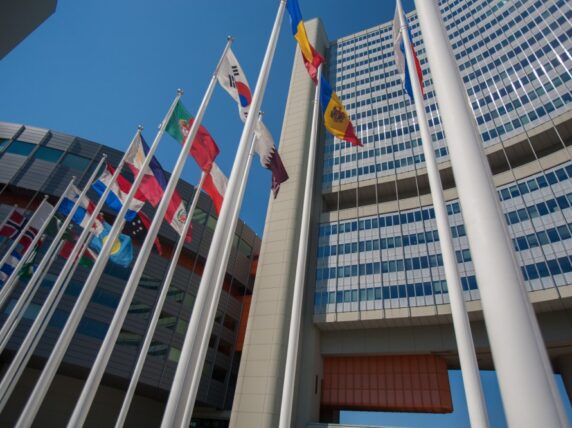Grand Bargain 2.0: Tinkering or transformation?
The Grand Bargain – one of the few tangible outcomes of the 2016 World Humanitarian Summit – was an agreement between the world’s largest humanitarian aid agencies and their donors.
It committed its signatories to financial and system-level reforms designed to make humanitarian assistance more efficient and effective while bringing together a “participation revolution” around the way the system engages with communities.
At the time of its signing, it promised to usher in a new era of humanitarian assistance. However, as implementation progressed, its limitations became all-too apparent.
It was described as “collapsing under the weight‘ of its over-structured bureaucracy. The chasm between the spirit of reform that ushered it in and its overly technocratic implementation was wide. Although its 63 signatories made some progress across its key workstreams, it was widely believed to have over-promised and under-delivered when it was phased out in 2020.
A new Grand Bargain
Enter Grand Bargain 2.0, which is currently under discussion. At first glance, there are encouraging signs that its architects have reflected on its flaws and acted on recommendations for improvements.
Subscribe to our newsletter
Our weekly email newsletter, Network News, is an indispensable weekly digest of the latest updates on funding, jobs, resources, news and learning opportunities in the international development sector.
Get Network NewsIts re-framing around community accountability is a key improvement. Its shrinking of 51 core commitments down to two promises more focus. And including local organisations in both its formal and informal structures from the outset is a crucial starting point. The formation of inclusive peer “caucuses” could also bring a welcome diversity and political bent to what was previously a narrow, technical exercise. And its two-year timeframe deliberately speeds up the implementation.
But will it deliver the change the sector needs? Does it go further than its predecessor? Or will it become another red herring that sucks energy and ambition from its signatories and distracts from more transformational areas of reform? If the Grand Bargain is to shift the needle on its twin ambitions of ‘localisation’ and ‘quality funding’, and to be worth the significant time and resource investment it will require, it needs to step up.
We need a bold vision, not a bargain
At the heart of the first Grand Bargain was the idea that reform could be achieved through a series of “deals” struck between donors and aid agencies where everybody benefited, such as more flexible funding in exchange for more transparency or more localisation for more compliance.
But this never materialised, stalling when negotiations broke down or progress was uneven. The new Grand Bargain’s wordy objective, “better humanitarian outcomes for affected populations through enhanced efficiency, effectiveness, and greater accountability, in the spirit of quid pro quo as relevant to all” could well be destined for the same fate.
What the initiative needs instead is a clear vision, a declaration of joint purpose and an articulation of how its individual activities will lead to system reform – something greater than the sum of its parts. Without an ambition for transformation, there is a risk that the agreement will remain incremental, technical and disconnected.
The Bargain needs political courage
Another key criticism of the first Grand Bargain was its inability to resolve the political tensions and trade-offs embedded in its design. Grand Bargain 2.0’s commitments also require uncomfortable and unpopular shifts in power, incentives, risk tolerance and resource flows. The shifts will require political engagement, courageous leadership and momentum.
As the process’ “eminent person” (an elitist and uninspiringly title) , Jan Egeland has the experience and easy charisma to both mobilise supporters and shame sceptics into getting behind him. But system-level reform cannot be achieved through strength of a single personality. He must find other progressives and champions within the current power holders to work alongside him. The multi-stakeholder caucuses could be instrumental in doing just that as long as they remain focused on unlocking key political barriers.
Do we need a Grand Bargain at all?
In the past, I’ve been a cautious Grand Bargain optimist. But as I now lead a civil society network, I am asking myself: Do we need a Grand Bargain at all
Can such important reforms be entrusted to entrenched organisations whose interests and ways of working run counter to reform? Or are we better off putting our resources and creative energy behind inspiring initiatives and movements that aren’t waiting for roadmaps and workstreams, and are instead generating change before our eyes?
I see examples of this across Start Network’s membership, hubs and change makers – ECOWEB in the Philippines, the Union for Promotion Protection, Human Rights Defense and the Environment in Goma, PIANGO in the Pacific, ASECSA in Guatemala – who, today, are working within communities to find solutions to humanitarian problems. They are not trying to change an old system, but are showing what alternative systems look like and how others can get there.
For me it comes down to a single question: tinkering or transformation? Without a more audacious vision, a more efficient and effective humanitarian system will remain out of the Grand Bargain’s reach. Without significant financial and political investment in communities, a locally led system is unlikely to materialise. We need to drive a harder bargain if real, palpable transformation is where we want to end up.
Category
News & views


